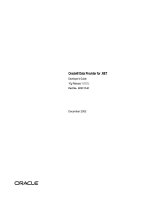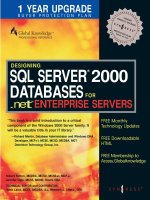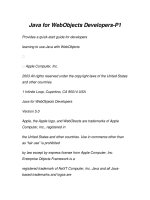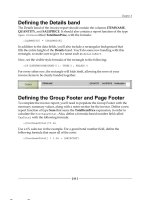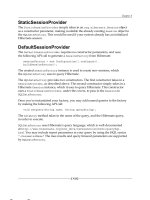HTML5 for .NET Developers docx
Bạn đang xem bản rút gọn của tài liệu. Xem và tải ngay bản đầy đủ của tài liệu tại đây (14.57 MB, 416 trang )
MANNING
Jim Jackson II
Ian Gilman
Single page web apps, JavaScript, and semantic markup
FOREWORD BY
Scott Hanselman
www.it-ebooks.info
HTML5 for .NET Developers
www.it-ebooks.info
www.it-ebooks.info
HTML5 for
.NET Developers
SINGLE PAGE WEB APPS, JAVASCRIPT
AND
SEMANTIC MARKUP
JIM JACKSON II
IAN GILMAN
MANNING
SHELTER ISLAND
www.it-ebooks.info
For online information and ordering of this and other Manning books, please visit
www.manning.com. The publisher offers discounts on this book when ordered in quantity.
For more information, please contact
Special Sales Department
Manning Publications Co.
20 Baldwin Road
PO Box 261
Shelter Island, NY 11964
Email:
©2013 by Manning Publications Co. All rights reserved.
No part of this publication may be reproduced, stored in a retrieval system, or transmitted, in
any form or by means electronic, mechanical, photocopying, or otherwise, without prior written
permission of the publisher.
Many of the designations used by manufacturers and sellers to distinguish their products are
claimed as trademarks. Where those designations appear in the book, and Manning
Publications was aware of a trademark claim, the designations have been printed in initial caps
or all caps.
Recognizing the importance of preserving what has been written, it is Manning’s policy to have
the books we publish printed on acid-free paper, and we exert our best efforts to that end.
Recognizing also our responsibility to conserve the resources of our planet, Manning books
are printed on paper that is at least 15 percent recycled and processed without the use of
elemental chlorine.
Manning Publications Co. Development editor: Renae Gregoire
20 Baldwin Road Technical proofreader: Roland Civet
PO Box 261 Copyeditor: Andy Carroll
Shelter Island, NY 11964 Proofreader: Melody Dolab
Typesetter: Dennis Dalinnik
Illustrator: Gerry Arrington
Cover designer: Marija Tudor
ISBN: 9781617290435
Printed in the United States of America
12345678910–MAL–18171615141312
www.it-ebooks.info
To my lovely bride, Michelle, and my beautiful daughters, Norah and Mary.
Thank you for your help, support, patience, and understanding.
—J.J.
To Christina and Caitlyn, my amazing wife-and-daughter team.
—I.G.
www.it-ebooks.info
www.it-ebooks.info
vii
brief contents
1
■
HTML5 and .NET 1
2
■
A markup primer: classic HTML, semantic HTML, and CSS 33
3
■
Audio and video controls 66
4
■
Canvas 90
5
■
The History API: Changing the game for MVC sites 118
6
■
Geolocation and web mapping 147
7
■
Web workers and drag and drop 185
8
■
Websockets 214
9
■
Local storage and state management 248
10
■
Offline web applications 273
www.it-ebooks.info
www.it-ebooks.info
ix
contents
foreword xv
preface xvii
acknowledgments xx
about this book xxii
about the cover illustration xxv
1
HTML5 and .NET 1
1.1 New toys for developers thanks to HTML5 3
New HTML5 tags and microdata 4
■
HTML5 applications
for devices 5
■
Better, faster JavaScript 6
Libraries, extensions, and frameworks 6
■
New HTML5
JavaScript APIs 9
■
Cascading Style Sheets 3 11
MVC and Razor 12
1.2 HTML5 applications end-to-end 12
Page structure and page presentation 13
■
Page content 14
Application navigation 15
■
Business logic 16
Server communications 17
■
The data layer 18
1.3 Hello World in HTML5 19
Creating the template 20
■
Customizing the application 22
Building the JavaScript library 24
■
Building the server side 28
1.4 Summary 32
www.it-ebooks.info
CONTENTS
x
2
A markup primer: classic HTML, semantic HTML, and CSS 33
2.1 Classic and semantic HTML markup: what’s
the difference? 34
2.2 Basic structural elements of all HTML tags 35
Working with the basic HTML tags 37
■
Making content flow
where you want with block and inline elements 40
■
Dividing data
into grids with table elements 42
■
Using HTML
form elements 43
2.3 Semantic HTML: The semantic blueprint 44
Grouping and dividing page content with content tags 46
Going beyond semantics with application tags 51
Using media tags for audio and video content 53
2.4 Styling HTML5: CSS basics 54
Understanding CSS syntax 54
■
Building selectors, the most
critical CSS element 55
■
Assigning fonts 56
■
Assigning and
manipulating colors 57
■
Changing the size of an element with
the box model 59
■
Using columns and blocks for layout 60
Changing screen layout based on changing conditions with
media queries 61
■
Adjusting an element’s presentation
and location with transitions and transformations 62
Changing styles as needed with pseudo-elements
and pseudo-classes 64
2.5 Summary 65
3
Audio and video controls 66
3.1 Building a site to play audio and video 68
3.2 Audio and video tags 71
Using audio and video tags without JavaScript 72
■
Using the
audio tag as an HTML element 73
■
Using the video tag
as an HTML element 74
3.3 Controlling audio and video playback with JavaScript 76
Building custom controls for audio and video 76
■
Building the
main.js library structure 78
■
Creating a JavaScript media
player object 79
■
Completing the media experience by adding
volume controls 80
3.4 Updating media types for open source content 83
3.5 Summary 85
3.6 Complete code listings 86
www.it-ebooks.info
CONTENTS
xi
4
Canvas 90
4.1 Canvas quick-start 92
Creating the basic Canvas site structure 93
■
Assigning size
to the canvas 94
■
Creating the stylesheet for the
sample application 95
■
Drawing with the 2d context object 96
Building the foundation object of the Canvas application 96
4.2 Creating and manipulating shapes, lines, images,
and text 97
Understanding the basic drawing process 98
Adding shapes 100
■
Adding lines 101
Adding images 103
■
Manipulating pixels 105
Adding text 107
4.3 Animating and adding special effects
to canvas images 108
Adding animation 108
■
Adding special effects with curves
and clipping 111
■
Managing canvas properties during
screen resizing 113
4.4 Summary 114
4.5 Complete code listing 114
5
The History API: Changing the game for MVC sites 118
5.1 Building a History-ready MVC site 120
Launching the sample project in Visual Studio 121
Adding controllers and views 122
■
History and
MVC routing 126
■
Creating the application data model 129
Loading content from the server on demand using
partial views 130
5.2 Using HTML5 History 133
Adding JavaScript to handle History API navigation events 135
Working with the page URL in JavaScript 139
■
Using History
to update the page 140
5.3 Two more small steps 141
5.4 Summary 144
5.5 The complete JavaScript library 144
6
Geolocation and web mapping 147
6.1 “Where am I?”: A (brief) geographic location primer 149
6.2 Building a geolocation application 153
Basic application setup 154
■
Using the Bing Maps
JavaScript API 157
www.it-ebooks.info
CONTENTS
xii
6.3 Using the Geolocation API 159
API functions for interacting with device location services 161
Plotting a point on a map 163
■
Integrating geolocation
and a map 165
■
Navigating the map using
geolocation data 167
6.4 Building a service to find address information 171
Modeling a point on the Earth in .NET 171
Displaying routes between coordinates 174
6.5 Summary 178
6.6 Complete code listings 178
7
Web workers and drag and drop 185
7.1 Getting started: Building an app that integrates Drag
and Drop and Web Workers 187
7.2 Implementing drag and drop in JavaScript 190
The HTML5 Drag-and-Drop API 191
■
Using the dataTransfer
object to pass data with drag-and-drop events 193
■
Building the
object to transfer data during drag and drop 194
7.3 HTML5 Web Workers 198
The basics: sending work to another thread 199
■
Integrating Web
Workers into a JavaScript library 203
7.4 Summary 208
7.5 The complete code listings 208
8
Websockets 214
8.1 HTTP and TCP—a quick primer 216
An HTTP overview 216
■
TCP communications
in a nutshell 217
8.2 Building a Websockets chat application 219
Separating interface logic from Websockets communications 222
Implementing Websockets in JavaScript 224
■
Opening a
Websockets server connection 227
■
Sending messages 230
Receiving messages 231
8.3 Using Node.js as a TCP server 234
8.4 Summary 241
8.5 The complete code listings 241
www.it-ebooks.info
CONTENTS
xiii
9
Local storage and state management 248
9.1 A LocalStorage example application 249
9.2 Structuring a JavaScript library to maintain state 253
Creating an application outline that supports local storage
of objects 253
■
Building UI elements that can be
stored locally 255
9.3 Using the LocalStorage API 257
Adding and removing items to and from LocalStorage
the not-so-easy way 257
■
Adding and removing items
the easy way 258
■
Moving data from LocalStorage
to the page 259
■
Deleting items from LocalStorage 260
Clearing all items from LocalStorage 260
■
Using the LocalStorage
storage event to detect changes 261
9.4 Adding UI elements to complete the application 262
9.5 Other uses for LocalStorage 264
Using LocalStorage as a proxy for server data 264
Using LocalStorage to save images 266
9.6 Summary 267
9.7 The complete code listings 267
10
Offline web applications 273
10.1 Building an offline HTML5 application 274
Creating the basic site structure 277
■
Creating the offline
JavaScript library 279
10.2 The manifest file 280
Adding the application manifest to the sample project 281
Exploring manifest sections 281
10.3 Offline feature detection and event binding 285
10.4 The ApplicationCache object 287
10.5 Adding state management and displaying
connected status 290
10.6 Building the server side of an offline application 295
10.7 Summary 300
10.8 The complete code listings 300
appendix A A JavaScript overview 307
appendix B Using ASP.NET MVC 346
appendix C Installing IIS Express 7.5 372
index 377
www.it-ebooks.info
www.it-ebooks.info
xv
foreword
HTML5
is taking over the world. Oh no!
.
NET
is dead! Java is dead!
Everything is dead and
HTML5
is the only technology left standing!
Wait, none of the above is true at all. It turns out that
HTML5
is a wonderful tool in
our toolbox, one that makes our other tools even better. In fact, learning
HTML5
is
one of the best things a .
NET
developer can do today. .
NET
on the server and
HTML5
in a new browser on the client are a killer combination.
Jim and Ian have written about
HTML5
in a voice that speaks directly to the inter-
ests and concerns of the .
NET
developer. The samples are clear and useful but also
coded from the perspective of an
ASP
.
NET
programmer who wants to get things done.
This is hugely helpful for existing
ASP
.
NET
and .
NET
coders who want to get up to
speed on
HTML5
.
HTML5
is a collection of new tags and bits of markup, but the term “
HTML5
” is
overloaded. It also encapsulates
CSS3
and new JavaScript
API
s, like GeoLocation and
LocalStorage. But
HTML5
is more than these new tools—it is more than a specifica-
tion; it’s a new way to think about writing web applications; it’s an assumption that
your client’s browser has capabilities and processing power that we couldn’t dream up
three years ago.
A few years ago, if you wanted a chart in a browser you’d either use Flash or dynam-
ically generate an image on the server side. Today, you can send the browser all the
data a chart needs via
JSON
and then let the user not only see a chart generated with
www.it-ebooks.info
FOREWORD
xvi
HTML5
Canvas, but also interact with or even change the data on the client. A few
years ago, your server was the only computer with the wherewithal to sort, query, and
manipulate interesting cubes of data. Today, you’ve got a tiny database and a powerful
JIT
’ed virtual machine inside your client’s web browser.
Fortunately for us all, you can write
HTML5
today with
ASP
.
NET
; and with the
release of
ASP
.
NET
4.5, we see additional support for
HTML5
. The latest Visual Studio
also adds improvements in JavaScript and
CSS3
editing. All of
HTML5
and its won-
drous bits and pieces are ready for you in Web Forms, Web Pages, and
MVC
. Your
ASP
.
NET
applications can generate
HTML5
that still works in older browsers thanks to
the Modernizr feature detection library. You can use
HTML5
and JavaScript on the cli-
ent to call
ASP
.
NET
Web
API
s on the server.
HTML5
is a technology that makes the .
NET
developer’s life more interesting!
There are many books that talk about
HTML5
as if it were an island, disconnected
from any server technology. This is not the case with
HTML5
for .
NET
Developers by Jim
and Ian. If you’re a longtime
ASP
.
NET
developer looking to bone up on new tech-
niques in web development, or if you’re just getting started with
ASP
.
NET
and you want
to make sure you’re attacking new problems in the most modern and progressive way,
this is the book for you.
S
COTT
H
ANSELMAN
W
EB
C
OMMUNITY
A
RCHITECT
M
ICROSOFT
www.it-ebooks.info
xvii
preface
In early 2010, I had just finished up a workflow proof-of-concept project and was pok-
ing around other projects at Applied Information Sciences, looking for what was next
in my software career. Since I had some Silverlight experience and wanted to expand
it further, I requested a role on a project to enhance a magazine viewer originally pro-
duced by Vertigo (vertigo.com) for Bondi Digital (BondiDigital.com). I ended up
rebuilding the processing software that imported the source images and data into the
viewer format. This was fortuitous because it was a project role that would continue
while many others rotated in and out over the next two years.
When the processing solution was complete, I got involved in the Silverlight area
of the application, and it was about this time that Apple’s new toy, the iPad, took off. It
seemed to the project stakeholders that an
HTML
-only version of our viewer would be
appropriate, so we got to work. For a traditional
ASP
.
NET
and Silverlight developer
like me, this was new ground, and it took a number of months and hundreds of dol-
lars in books for me to get my footing with JavaScript and to unlearn all the bits and
pieces of
ASP
.
NET
that hide the true nature of
HTML
,
CSS
, and JavaScript.
With a little knowledge and the help of other
AIS
employees who were working
with Manning Publications on various book ideas, I got Mike Stephens’ name and
called over to discuss a book proposal on Silverlight and
GIS
, my hobby and one of my
technology passions. We were pretty close to writing up a book contract when a Micro-
soft employee happened to mention in an interview that they (
MS
) were “refocusing”
Silverlight. This came as a shock to all of the Silverlight developers and client companies
who had been investing heavily in the technology for rich client-side web solutions.
www.it-ebooks.info
PREFACE
xviii
Despite some backtracking and spinning the news, this appears to have been a cor-
rect move on Microsoft’s part. While Silverlight is certainly not dead, it has been
eclipsed by
HTML5
in terms of industry hype and project work moving forward. For
web consultancies, this is not such a huge problem, because
ASP
.
NET
MVC
is a top-tier
platform on which to build rich client-side
HTML
applications. Windows 8 allows
HTML
/
CSS
and JavaScript as first-class development languages for native software! It’s
not a panacea, but it is a great tool to have in the belt.
While all of this was happening in the industry, I became more involved in the new
HTML
version of the magazine viewer application. And because the Silverlight/
GIS
book was clearly not going to fly in the marketplace, Mike at Manning asked what
other applications I was working on. I responded that we were building a rich
HTML5
client, integrating
ASP
.
NET
MVC
and deploying it to
SQL
Azure and Azure Web Roles.
“We could do a book about any of those things!” was Mike’s response. Of course,
I didn’t think I was nearly qualified enough to write such an authoritative tome, but
Mike convinced me that I was, in fact, in the perfect position to do so. As a seasoned
developer who had moved from strict
ASP
.
NET
and rich-client C# applications into
JavaScript and
HTML
, I was in a good position to describe the technologies from a
common perspective.
During the writing of this book we took a few detours to come to the current for-
mat. The initial idea, when I was the sole author, was to build a single application that
integrated
HTML5
API
s into a reference framework. This turned out to be a dead
end. The Microsoft Silk project was working on the same thing, only they had actual
members of the jQuery team looking over their shoulders and helping them out.
This was not a competitive position for our book, and Manning was not excited about
the idea of a single-project book; such books can lead to content that is more focused
on the project than on learning the technology. The next iteration led to the current
focus of one project per chapter and also to the realization that I was not experi-
enced enough to write what could be termed “reference-level” JavaScript code. The
manager on the magazine viewer project was lucky enough to find and contract with
Ian Gilman, and his expertise provided immediate improvements to that platform
and to our collective expertise in JavaScript. Ian is an expert technician and an excel-
lent communicator, so he was a natural choice for the project and for this book. He
also brought in the Git source control expertise. You can see our source repository at
www.github.com/axshon/
HTML
-5-Ellipse-Tours, where Ellipse Tours is the original
name of the single project.
The next version of the book was nearly complete in early 2012 when Manning
decided that a new development editor would be added to the project. With the
help of Renae Gregiore, Ian and I reworked the book to focus more on the use of
each
HTML5
API
, rather than providing deep reference material and then trying to
spend the last few pages of each chapter building a project with it. This final format
reduced the size of the book by moving the
MVC
-focused chapter and the JavaScript
chapter into appendices.
www.it-ebooks.info
PREFACE
xix
The format you find within these pages is our collective attempt to find the friend-
liest, fastest route from .
NET
developer to
HTML5
/JavaScript expert. Most of the text,
server-side code, and JavaScript code comments you will find here are my words, and
most of the JavaScript,
HTML
, and
CSS
is Ian’s work.
We hope that you find the contents informative and interesting. More importantly,
we hope that our book gives you great ideas for fantastic and fun new software prod-
ucts. If you have an interesting project that you’d like to make some noise about, feel
free to contact me at
J
IM
J
ACKSON
www.it-ebooks.info
xx
acknowledgments
We would like to thank the many people who helped make our book possible, starting
with everyone at Manning, from associate publisher Mike Stephens and our develop-
ment editor Renae Gregoire, to the production team of Mary Piergies, Troy Mott,
Andy Carroll, Melody Dolab, Janet Vail, and Dennis Dalinnik.
Special thanks to Scott Hansleman for happily volunteering to write the foreword.
We are deeply grateful for his endorsement of our work. We also acknowledge Roland
Civet, our technical proofreader, who reviewed the text and tested the code during
development and again shortly before the book went to press.
The following reviewers read our manuscript at various stages of its development
and we thank them for their feedback and insights: Adam London, Arsalan Ahmed,
Arun Noronha, Asif Jan, Francis Setash, Ian Stirk, Jeffrey Jenkins, Joseph M. Morgan,
Leo Waisblatt, Mark Nischalke, Osama Morad, PhD, Paul Stack, Peter O’Hanlon,
Philippe Vialatte, Rohit Asthana, Stan Bice, and Wyatt Barnett.
Thanks also to Mark LaPointe, John Blumenauer, Glenn Block, Julie Lerman, Tad
VanFleet, Steve Michelotti, Oskar Austegard, Ernesto Delgado, and Pete Brown.
Thanks for the pointers, direction, and help from the following Microsoft teams: Web
API
s, Project Silk, Internet Explorer, and Interoperability Bridges.
Jim Jackson
Many thanks to Ian Gilman who helped to make this book what it is. His knowledge,
work, and tireless attention to detail have resulted in a book that I believe will be truly
helpful in bringing more and more .
NET
developers into the age of
HTML5
.
www.it-ebooks.info
ACKNOWLEDGMENTS
xxi
Heartfelt thanks to my wife for being so patient, supportive, and encouraging dur-
ing all the late nights, early mornings, and times when it would have been easier for
me to stop than continue. The fact that we got through it together is a testament to
your faith in me. You are truly appreciated.
Ian Gilman
For their insights and support, thank you to Kevin Hanes, Ben Vanik, Daniel Gasienica,
Aseem Kishore, Oskar Austegard, Gennaro Cannelora, and of course Christina Gilman.
Thank you most of all to Jim, for bringing me into this endeavor with his great passion
for knowledge; it’s been a wild ride!
www.it-ebooks.info
xxii
about this book
This book was written for professional .
NET
developers primarily focused on C# and
ASP
.
NET
. While it’s useful for other professionals, the focus has been on developing
server-side code in C# and
ASP
.
NET
MVC
, with as little overhead as possible.
Our target reader is a professional who has been placed in the role of developer
on a project that is already on an
HTML5
and
ASP
.
NET
MVC
platform or is being transi-
tioned to this platform. Emphasis is placed on as many stable parts of the
HTML5
spec-
ification as possible, so that while the developer learns effective use of JavaScript, he
or she is also able to learn to use these very powerful
API
s.
Please note that while the JavaScript and
HTML5
techniques you learn in these
pages are useful for Windows 8 development, this book does not claim to be a Win-
dows 8 development reference.
How the book is organized
This book is divided into two parts. The first part, consisting of chapters 1 and 2, will
give you a general understanding of what
HTML5
is and how it can interact with server
components using JavaScript and
ASP
.
NET
MVC
. Chapter 2 focuses on markup and
how semantics play a role in
HTML5
web application development.
The second part of the book (chapters 3 to 10) covers the various
HTML5
JavaScript
API
s that are stable and generally supported across browser platforms. Each
implementation is tested against browser versions that were available at the time of
writing and against previous versions as much as possible. The
API
s covered in each
chapter are as follows:
www.it-ebooks.info
ABOUT THIS BOOK
xxiii
■
Chapter 3 Audio and video controls
■
Chapter 4 Canvas
■
Chapter 5 The History
API
: Changing the game for
MVC
sites
■
Chapter 6 Geolocation and web mapping
■
Chapter 7 Web workers and drag and drop
■
Chapter 8 Websockets
■
Chapter 9 Local storage and state management
■
Chapter 10 Offline web applications
There are three appendixes; they give an overview of JavaScript, explain how to use
ASP
.
NET
MVC
, and guide you on how to install
IIS
Express.
How to use this book
Each chapter in the second part of the book (chapters 3 to 10) is organized into three
parts. The first is a brief introduction, designed to get you thinking about real-world
applications for that chapter’s focus. This part may also include background informa-
tion to help you understand the topic more clearly, as is the case with geolocation.
The introduction also includes a browser support table that shows which browser ver-
sions are compatible with each
HTML5
API
.
The second part of the chapter is the actual build. As we build the project, we’ll
show the code and describe where it should be placed in the application source. As
each part of an
API
is used, it’s introduced and defined. A Core
API
icon placed in the
margin shows the section where each
API
is discussed.
The third and final part of each chapter is the source code listing. Each JavaScript
library,
HTML
page, stylesheet, or C# class file that is used will be fully listed, unless
that code was previously listed in an earlier part of the chapter. For example, if the
complete markup for an
HTML
page is listed early in the chapter, it won’t be listed
later. However, if a JavaScript file is created bit-by-bit as the project progresses, the
entire listing will be included in this section.
Working versions of each sample application can be found at www.ellipsetours.com/
demos/index.html. The code can also be downloaded from the publisher’s website at
www.manning.com/
HTML5
for.
NETD
evelopers.
Software requirements
The JavaScript portions of this book are completely compatible with any modern desktop
or mobile browser. The builds for each chapter require Visual Studio 2010 Service Pack 1
or later. All applications have been tested using Visual Studio 2012 Release Candidate.
Local administrator privileges are required to install Git Bash and node.js, as well
as to run these applications.
Each chapter starts off with a browser support table that shows which browser ver-
sions are compatible with each
HTML5
API
.
Core API
www.it-ebooks.info
ABOUT THIS BOOK
xxiv
Code conventions and downloads
All source code in listings or in text is in a
fixed-width
font
like
this
to separate it
from ordinary text. Code annotations accompany many of the listings, highlighting
important concepts.
Source code for all working examples in this book is available for download at the
publisher’s website at www.manning.com/
HTML5
for.
NETD
evelopers. Working ver-
sions of each sample application can be found at www.ellipsetours.com/demos/
index.html.
Author Online
The purchase of
HTML5
for .
NET
Developers includes free access to a private web forum
run by Manning Publications, where you can make comments about the book, ask tech-
nical questions, and receive help from the author and from other users. To access the
forum and subscribe to it, point your web browser to www.manning.com/
HTML5
for
.
NETD
evelopers. This page provides information about how to get on the forum once
you’re registered, what kind of help is available, and the rules of conduct on the forum.
Manning’s commitment to our readers is to provide a venue where a meaningful
dialogue between individual readers and between readers and the authors can take
place. It’s not a commitment to any specific amount of participation on the part of the
authors whose contribution to the book’s forum remains voluntary (and unpaid). We
suggest you try asking the authors some challenging questions, lest their interest stray!
The Author Online forum and the archives of previous discussions will be accessi-
ble from the publisher’s website as long as the book is in print.
www.it-ebooks.info




